Review and descriptions of the best potato varieties for growing in the Urals: early, middle and late
Gone are the days when it was believed that growing good potatoes in the Urals is almost impossible. Thanks to the incessant selection work of scientists, a real chance has appeared to argue with nature and achieve a full harvest of this crop, beloved by many.
Now even a novice summer resident can choose the most suitable variety for their needs and requirements and get potatoes of excellent quality.
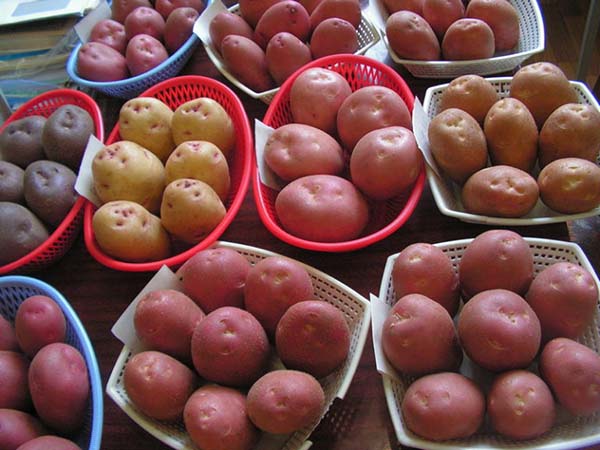
Content
What varieties of potatoes are suitable for growing in the Urals
For each region, you should choose only potato varieties that correspond to climatic conditions, especially when it comes to the Urals or Siberia. Only in this case it will be possible to get a good and stable harvest annually.Indeed, for the regions of the Urals in summer, both rainy warm weather with a short-term rise to +35 degrees and the invasion of Arctic air masses, accompanied by strong winds, a sharp drop in temperature, frost, and sometimes even snowfall in the first half of June, are typical.
However, it is not at all necessary to choose only early varieties; many mid-early, mid-season and even mid-late (for example, the most famous is Lorkh) varieties are quite suitable. In addition, the optimal variety should be chosen according to other important characteristics, such as culinary type, in other words, for what purposes the potatoes will be used: for making soups, salads, mashed potatoes, boiling, frying or producing french fries, chips.
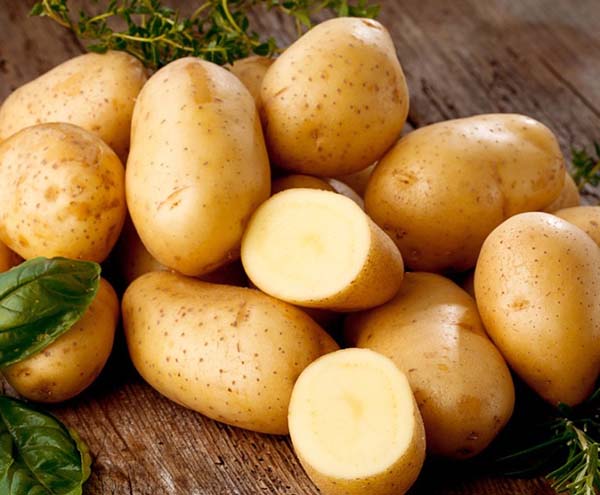
The Ural region includes the following entities *:
- Republic of Bashkortostan;
- Kurgan region;
- Orenburg region;
- Chelyabinsk region.
*Attention! The data are presented in accordance with the classification by regions of admission of the Federal State Budgetary Institution "State Commission of the Russian Federation for the Testing and Protection of Breeding Achievements".
Officially, the Ural Federal District includes the Kurgan, Sverdlovsk, Tyumen (+ UGRA + Yamalo-Nenets Autonomous District) and Chelyabinsk regions. The Republic of Bashkortostan and the Orenburg Region are formally included in the Volga Federal District.
In addition, according to the classification of this state body, the Tyumen region is included in the West Siberian, and the Sverdlovsk region - in the Volga-Vyatka regions of admission.
The best potato varieties for the Urals: top-16
Next, we will take a closer look at the most popular potato varieties that are allowed for planting and growing in the Urals (alphabetically):
Alyona
An early variety, for table use, good yield and taste.
The variety has a stable yield, a consistent return of early production, drought tolerance and suitability for mechanized cultivation technology.
Responds very well to germination.
Resistant to the causative agent of potato cancer. Susceptible to nematode and late blight. Resistant to common scab, rhizoctonia.
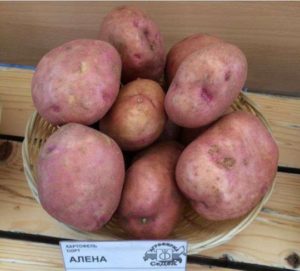
The taste is good. Culinary type VS. The digestibility is moderate. The pulp does not darken. Suitable for soups, frying. Suitable for making crispy potatoes and French fries.
Characteristics of the Alena variety:
- ripening period - early (70-80 days);
- tubers are oval;
- the structure of the peel is smooth;
- peel color - red;
- the color of the pulp is white;
- the depth of the eyes is shallow;
- starch content - 15-17%;
- yield per hundred square meters - 172-292 kg (maximum up to 391 kg);
- the number of tubers per bush - 6-10;
- the average weight of 1 tuber is 86-167 g;
- marketability - 81-97%;
- keeping quality - 95%.
The appearance of the plant - bushes of medium height, intermediate type, spreading. The leaf is large, wide, green. No or very slight waviness in the edge. Inflorescences are medium-sized, reddish-purple. Berry formation is very rare.
Recommended for planting regions: Volgo-Vyatka, Ural, West Siberian, East Siberian, Far East.
Patent holder and / or originator of the variety: Federal State Budgetary Scientific Institution "Omsk ANC" (Russia).
Bellarosa (Bella Rose or White Rose)
A variety of early ripening, table use, good yield and taste.
Interesting! Due to the specific bright red color of the peel in Russian-speaking countries, the variety received the popular name Cherry.
The variety is not picky about moisture and perfectly tolerates hot periods without loss of fruit quality. Any type of soil is suitable except for heavy loamy soil.
Advice! It is advisable to germinate before planting. Positively responds to fertilization.
In most cases, it manages to bloom by the time a massive amount of the Colorado potato beetle appears. Also, the variety is resistant to the causative agent of potato cancer and nematodes. It tolerates transportation well.
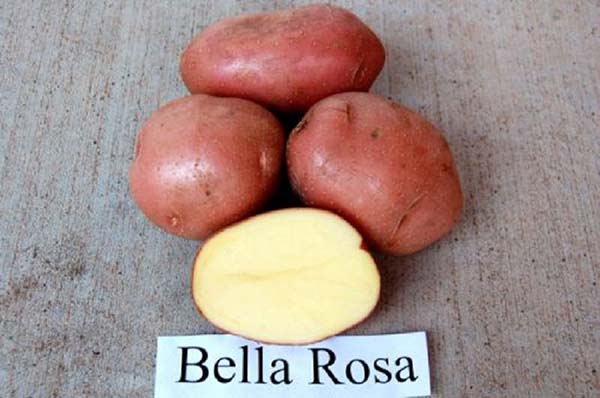
The taste is good. During the cooking process, the pulp becomes crumbly.
Young potatoes can be dug in on the 45th day after germination.
Characteristics of the Bellarosa variety:
- ripening period - early (70-80 days);
- the shape of the tubers is oval-round;
- the structure of the peel is rough;
- peel color - red;
- pulp color - light yellow;
- the depth of the eyes is shallow or medium;
- starch content - 12.6-15.7%
- yield per one hundred square meters - 169-326 kg (maximum up to 385 kg);
- the number of tubers per bush - 8-9;
- the average weight of 1 tuber is 117-207 g;
- marketability - 82-99%;
- keeping quality - 93%.
The appearance of the plant - forms tall erect shoots, with large green leaves. The inflorescences are medium and have a red-purple hue.
Regions recommended for planting: North-West, Volgo-Vyatsky, Central Black Earth Region, Uralsky.
Patent holder and / or originator of the variety: Europlant Pflanzenzucht GmbH (Germany).
Vineta (Veneta)
An early variety for table use, medium yield and good taste.
Suitable for growing in regions with harsh climates.
Resistant to the causative agent of potato cancer and nematodes. Susceptible to late blight pathogen in tops, moderately susceptible to tubers. Resistant to wrinkled and banded mosaic viruses, leaf curling, drought tolerant.
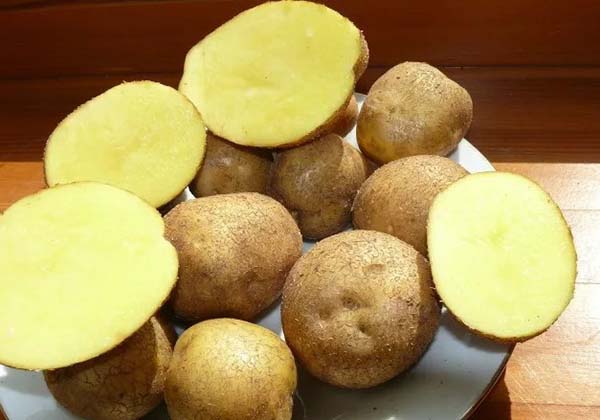
The taste is good and excellent. Culinary type B. In the process of cooking, Veneta does not boil over (boil-through is low), therefore it is recommended for preparing salads.
Note! Excessive application of nitrogen to the soil negatively affects the keeping quality of fruits.
Characteristics of the Vineta (Veneta) variety:
- ripening period - early (70-80 days);
- the shape of the tubers is oval-round;
- the structure of the peel is slightly reticulate;
- peel color - yellow;
- pulp color - light yellow;
- the depth of the eyes is shallow;
- starch content - 12.9-15.2%;
- yield per hundred square meters - 160-228 kg (maximum up to 238 kg);
- the number of tubers per bush - 10-12;
- average weight of 1 tuber - 67-95 g
- marketability - 87-97%;
- keeping quality - 87%.
The appearance of the plant is spreading. The leaf is light green. Low to medium waviness. Corolla small to medium in size, white inflorescences.
Recommended for planting regions: Central, Volgo-Vyatka, TsChO, North Caucasian, Srednevolzhsky, Uralsky.
Patent holder and / or originator of the variety: Europlant Pflanzenzucht GmbH (Germany).
Zhukovsky early
An early variety for table use, high yield and medium flavor.
It perfectly adapts to changing climatic conditions, is relatively heat and drought resistant. The yield is stable.
Important! Zhukovsky grows amicably even in poorly warmed soil, so the variety can be safely planted at the end of April.
Resistant to potato crayfish and nematodes. Susceptible to tops and tubers to the causative agent of late blight. The tubers are resistant to mechanical damage.
The taste is satisfactory and good. Culinary type B. Boiled weak. During the cooking process, the pulp darkens slightly. Great for frying, making French fries, and making chips. Can be used for puree and cooking, but not very suitable.
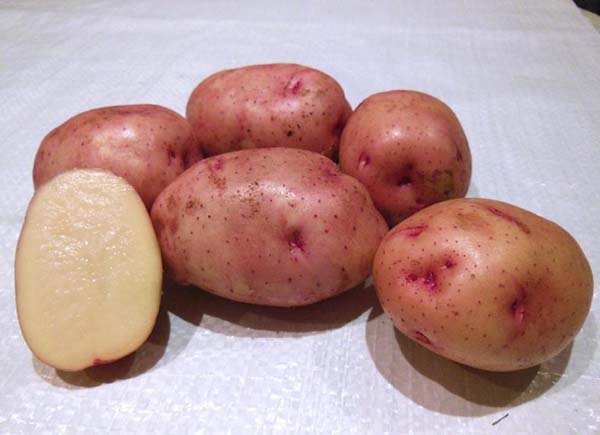
Characteristics of the early Zhukovsky variety:
- ripening period - early (70-80 days), according to other sources, very early (60-80 days);
- the tubers are oval-round;
- the structure of the peel is smooth;
- peel color - pink;
- the color of the pulp is white;
- the depth of the eyes is shallow;
- starch content - 10-12%;
- yield per one hundred square meters - 400-450 kg;
- the number of tubers per bush - 9-15;
- the average weight of 1 tuber is 100-120 g;
- marketability - 90-92%;
- keeping quality is good.
Appearance - bushes of medium height, semi-spreading stem type, the leaf is small, green (glossy), the flowers have a red-violet hue. Berry formation is rare.
Recommended for planting regions: North-West, Central, Volgo-Vyatka, Central black earth, North Caucasian, Middle Volga, Nizhnevolzhsky, Ural, West Siberian, Far East.
Patent holder and / or originator of the variety: FGBNU “All-Russian Research Institute of Potato Farming named after A.G. Lorkha (Russia).
Kamensky
The variety is early maturing, for table use, medium yield and good taste.
It is characterized by early harvest accumulation and leveled tubers with high marketability.
It adapts well to all types of soil. Differs in drought resistance due to the early formation of tubers. Requires loosening of the soil, responds positively to fertilization and watering. The tough leaves of adult plants do not like the Colorado potato beetle.
Resistant to the causative agent of potato cancer. Susceptible to nematode. Medium resistant to late blight pathogen, resistant to wrinkled and banded mosaics, leaf twisting, common scab and rhizoctonia.
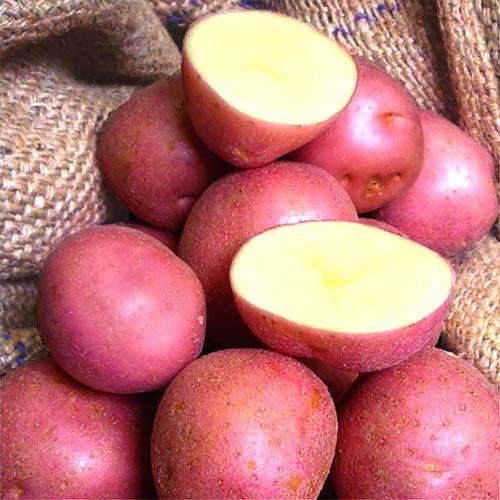
The taste is good. Culinary type B (poor digestibility).
Variety characteristics:
- ripening period - early (70-80 days);
- the shape of the tubers is elongated-oval;
- the structure of the peel is smooth;
- peel color - red;
- pulp color - light yellow;
- the depth of the eyes is shallow;
- starch content - 12.2-16.8%;
- yield per hundred square meters - 185 kg (maximum up to 252 kg);
- the number of tubers per bush - 15-25;
- the average weight of 1 tuber is 96-108 g;
- marketability - 85-94%;
- keeping quality - 97%.
The appearance of the plant is of an intermediate type, semi-erect. Medium leaf, intermediate type, dark green. Strong edge waviness. The intensity of the anthocyanin coloration of the inner side of the corolla is from medium to strong, the proportion of blue is absent or very small. The inflorescences are large. and red and purple. Berry formation is rare.
Recommended for planting regions: Volgo-Vyatka, Ural, West Siberian.
Patentee and / or originator of the variety: FGBNU "Ural Research Institute of Agriculture" (Russia).
Labella
An early variety, for table use, medium yield, excellent taste.
Resistant to high temperatures during the growing season, has excellent adaptability to climatic conditions and soil types.
Resistant to the causative agent of potato cancer and nematodes. Highly resistant to leaf roll virus.
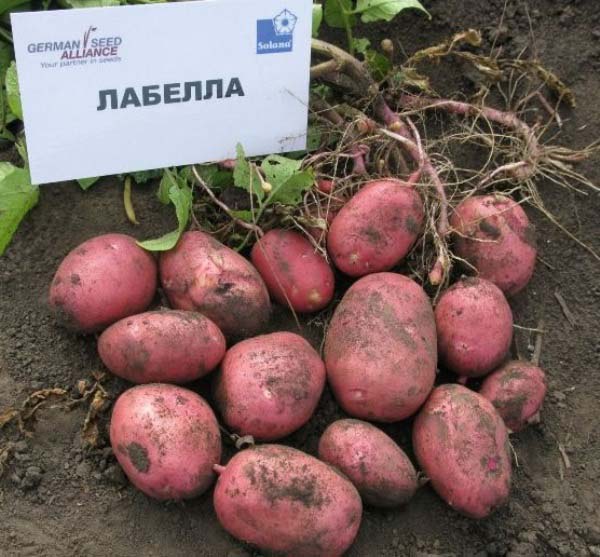
The taste is excellent. The digestibility is average.
Characteristics of the Labella variety:
- ripening period - early (70-80 days);
- the shape of the tubers is elongated-oval;
- the structure of the peel is smooth;
- peel color - red;
- the color of the pulp is yellow;
- the depth of the eyes is shallow to medium;
- starch content - 15.8%;
- yield per hundred square meters - 176-264 kg (maximum up to 342 kg);
- the number of tubers per bush - up to 14;
- the average weight of 1 tuber is 78-102 g;
- marketability - 91-92%;
- keeping quality - 98%.
The appearance of the plant is from medium height to high, leaf type, semi-erect. The leaf is large, intermediate, green. Inflorescences are red-purple.
Recommended for planting regions: Central, North Caucasian, Middle Volga, Ural.
Patent holder and / or originator of the variety: Den Hartigh BV (Holland).
Lorch
Medium late variety, for table use, good yield and excellent taste.
One of the oldest Russian potato varieties, registered in 1931, and bred by Alexander Georgievich Lorkh in 1922.
A versatile variety.
Possesses high plasticity to cultivation conditions.
Important! It does not tolerate drought and slows down its growth at high temperatures, which leads to the formation of children and provokes sprouting (a new tuber appears from the finished development).
Moderately susceptible to late blight in tops and tubers, common scab, moderately resistant to rhizoctonia.
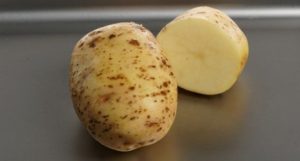
Lorkh's taste is excellent. Culinary type C. The digestibility is good. Ideal for puree. During the cooking process, the shade of the pulp does not darken. Suitable for starch production.
Characteristics of the Lorkh variety:
- ripening period - medium late (110-120 days);
- the shape of the tubers is round-oval;
- the structure of the peel is smooth, flaky at the top;
- peel color - light beige;
- the color of the pulp is white;
- the depth of the eyes is shallow;
- starch content - 15-20%;
- yield per hundred square meters - 250-350 kg;
- the number of tubers per bush - 15-25;
- the average weight of 1 tuber is 90-120 grams;
- marketability - 88-92%;
- keeping quality is good.
The appearance of the plant is tall, has well-branched leafy shoots and medium-sized light green leaves. Differs in pale reddish-purple flowers, with white edging around the edge of the petals. Berry formation is rare.
Regions recommended for planting: North-West, Central, Central Black Earth Region, North Caucasian, Middle Volga, Nizhnevolzhsky, Uralsky.
Patent holder and / or originator of the variety: FGBNU “All-Russian Research Institute of Potato Farming named after A.G. Lorkha (Russia).
Lugovskoy
Mid-season growth, table purpose, high yield, good taste.
It is characterized by a stable yield. Can be grown in almost any climatic conditions.
In the process of cultivation, it responds well to hilling and deep loosening of the soil.
Resistant to cancer, relatively resistant to late blight, common scab, moderately resistant to viruses, blackleg.
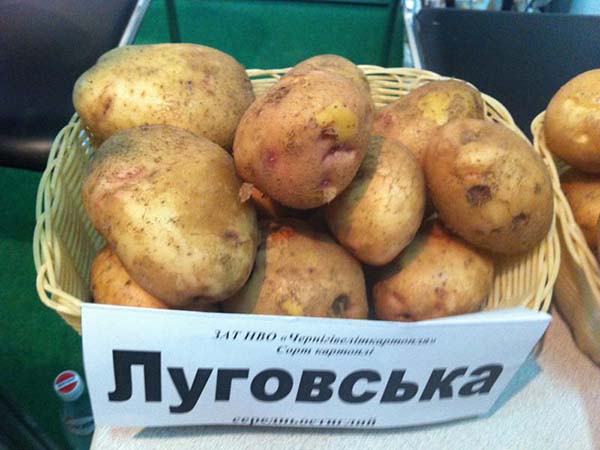
The taste is good, without excessive dryness and wateriness. The pulp does not darken. Lugovsky is recommended for making mashed potatoes and getting starch.
Characteristics of the Lugovskoy variety:
- ripening period - mid-season (90-110 days);
- tubers are oval;
- the structure of the peel is mesh;
- peel color - light pink;
- the color of the pulp is white;
- the depth of the eyes is shallow;
- starch content - 12-19%;
- yield per hundred square meters - high (maximum up to 514 kg);
- the number of tubers per bush - 10-15;
- the average weight of 1 tuber is 85-125 g;
- marketability - high;
- keeping quality is good.
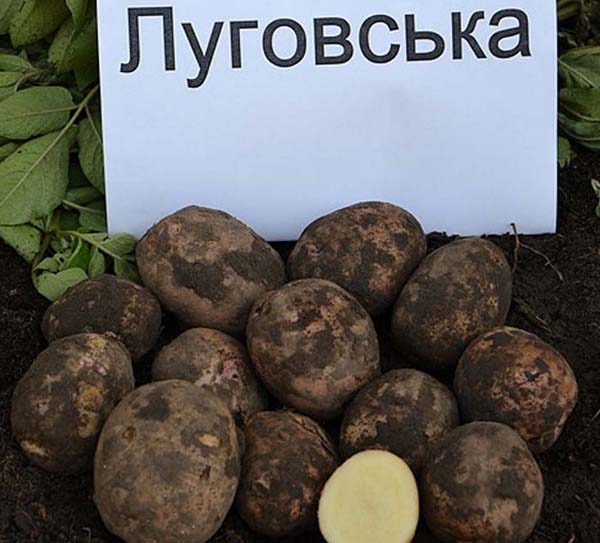
The appearance of the plant is erect, of medium height, the color of the flowers is white.
Recommended for planting regions: North, North-West, Central, Volgo-Vyatka, Central Black Earth Region, North Caucasian, Nizhnevolzhsky, Ural, West Siberian, East Siberian, Far East.
Patent holder and / or originator of the variety: Institute of Potato Growing UAAS (Ukraine).
Lyubava
An early variety, for table use, high yield, good taste. Culinary type A (salad type). Does not boil over. The pulp darkens moderately during cooking.
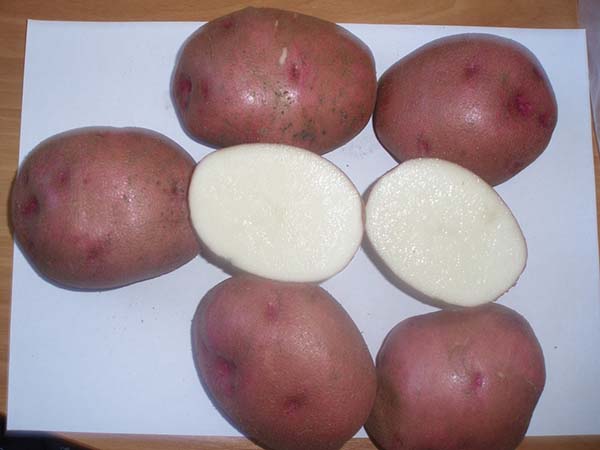
Resistant to the causative agent of potato cancer, rhizoctonia, susceptible to nematode. It is also susceptible in terms of tops and moderately resistant in tubers to the causative agent of late blight. Moderately resistant to common scab.
Characteristics of the Lyubava variety:
- ripening period - early (70-80 days);
- the shape of the tubers is oval-round;
- the structure of the peel is from medium to coarse (according to other sources, it is generally suitable, but flaky at the top);
- peel color - red;
- the color of the pulp is white;
- the depth of the eyes is average;
- starch content - 11.2-16.9%;
- yield per hundred square meters - 288-400 kg (maximum up to 524 kg);
- the number of tubers per bush - 8-15;
- the average weight of 1 tuber is 109-210 g;
- marketability - 80-98%;
- keeping quality is good.
The appearance of the bushes is of medium height, intermediate type, semi-erect. The leaf is small, open, light green. The waviness of the edge is weak. Average gloss. Inflorescences are medium-sized, reddish-purple. Berry formation is rare.
Recommended for planting regions: Ural, West Siberian, East Siberian, Far East.
Patent holder and / or originator of the variety: FGBNU “All-Russian Research Institute of Potato Farming named after A.G. Lorkha (Russia).
Meteor
Very early variety, for table use, high yield, good taste.
Good adaptability to any agro-climatic conditions, heat and drought resistance. It prefers to grow on loamy soil.
Resistant to the causative agent of potato cancer, nematode. Relatively resistant in leaves and highly resistant in tubers to the causative agent of late blight, moderately resistant to wrinkled and banded mosaics, common scab and rhizoctonia. Resistant to mechanical damage.
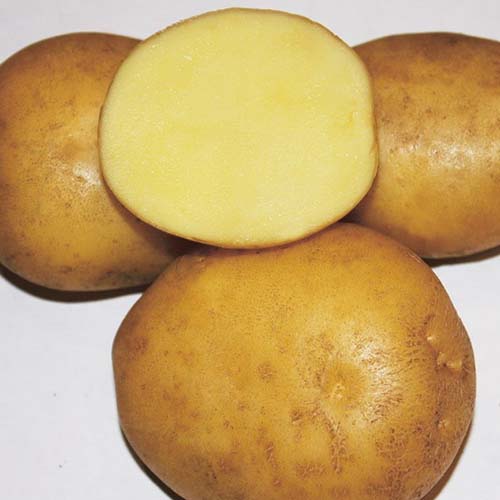
It is characterized by good taste and low digestibility. Culinary type VS. The pulp does not darken during cooking. Suitable for all kinds of dishes. Recommended for frying and baking.
Characteristics of the Meteor variety:
- ripening period - very early (60-80 days);
- the shape of the tubers is oval-round;
- the structure of the peel is smooth;
- peel color - yellow;
- pulp color - light yellow;
- the depth of the eyes is shallow to medium;
- starch content - 12.0-14.9%;
- yield per hundred square meters - 209-404 kg (maximum up to 450 kg);
- the number of tubers per bush - 10-12;
- the average weight of 1 tuber is 102-147 g;
- marketability - 88-98%;
- keeping quality - 95%.
The appearance of the plant is tall, intermediate type, semi-erect. Medium-sized leaf, dark green. The intensity of anthocyanin coloration on the inner side of the corolla is absent or very weak. Inflorescences are small, white. Berry formation is rare.
Recommended for planting regions: Central, Volgo-Vyatka, TsChO, Srednevolzhsky, Uralsky, West Siberian, Far Eastern.
Patent holder and / or originator of the variety: FGBNU “All-Russian Research Institute of Potato Farming named after A.G. Lorkha (Russia).
Nevsky
Medium early variety, for table use, high yield and average (satisfactory) taste.
By the way! According to some sources, the most popular potato variety in Russia.
Suitable for all regions. Nevsky gives good results when grown on sandy loam and loamy soils with a deep arable layer. Resistant to drought and waterlogging.
Important! When planting, it requires preliminary warming up of the seed (you can not plant it directly into cold soil), it is sensitive to the breaking off of sprouts. Responds well to plentiful feeding. To avoid scab damage, requires moist soil at the time of tuber formation.
Resistant to the causative agent of potato cancer, rhizoctonia, potato viruses. Moderately resistant to common scab. Moderately susceptible to late blight in tops and tubers. Resistant to mechanical damage. However, tubers tend to germinate during long-term storage.
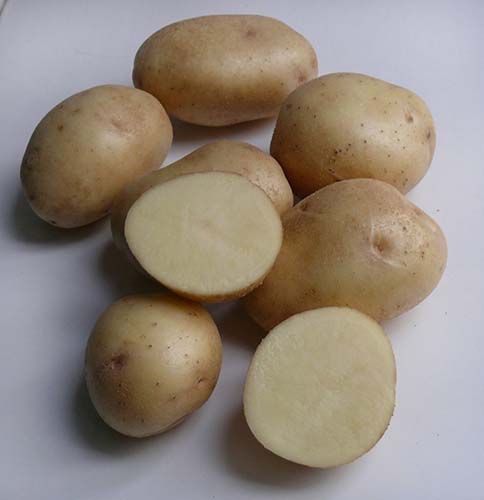
The taste is satisfactory or good. Culinary type VS. The digestibility is poor. The pulp does not darken during the cooking process. Nevsky is suitable for preparing first courses (soups) and second courses (salads), but due to its low starch content, it is not very suitable for mashed potatoes and frying.
Characteristics of the Nevsky variety:
- ripening period - medium early (80-90 days);
- the shape of the tubers is oval, aligned;
- the structure of the peel is smooth or mesh;
- peel color - light beige with pink eyes;
- the color of the pulp is white;
- the depth of the eyes is shallow;
- starch content - 10-12%;
- yield per hundred square meters - 380-500 kg;
- the number of tubers per bush - 17-20;
- the average weight of 1 tuber is 90-130 g;
- marketability - 90-95%;
- keeping quality is good.
The appearance of the plant is semi-erect, intermediate type, of medium height. The leaf is medium, light green, the edge waviness is weak. The flowers are white. Berry formation is average.
Recommended regions for planting: absolutely all regions.
Patent holder and / or originator of the variety: Federal State Budgetary Scientific Institution "Leningrad Scientific Research Institute of Agriculture" Belogorka "(Russia).
Rosara
An early variety, versatile, high-yielding, good taste.
Regardless of climatic conditions, it is able to give a stable harvest. Not damaged during transportation. It is characterized by amicable ripening of tubers.
When grown, responds well to watering, fertilization.
Resistant to cancer and potato nematode, slightly affected by late blight and common scab.
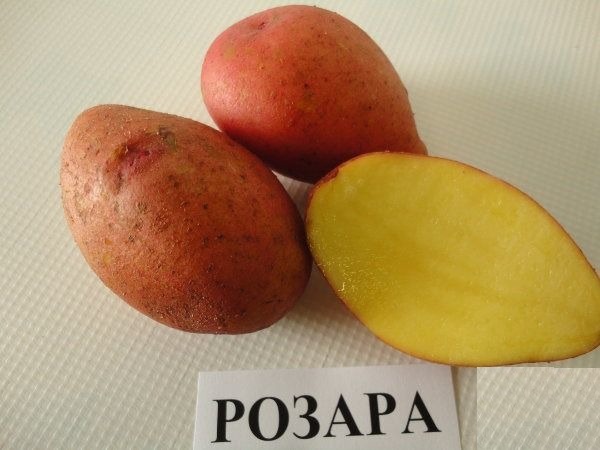
Taste good or great. In the process of cooking, it almost does not boil down, so the variety is ideal for salads, frying, cooking french fries, chips. Not suitable for mashed potatoes and cooking.
Characteristics of the Rosara variety:
- ripening period - early (70-80 days);
- tubers are oblong-oval;
- peel color - red;
- the color of the pulp is yellow;
- the depth of the eyes is shallow;
- starch content - 12.1-15.8%;
- yield per one hundred square meters - 202-310 kg (maximum up to 415 kg);
- the number of tubers per bush - 15-20;
- the average weight of 1 tuber is 81-115 g;
- marketability - 91-99%;
- keeping quality - 97% (good).
The appearance of the plant is a bush of medium height, semi-spreading. The flowers are red-purple.
Recommended for planting regions: North-West, Volgo-Vyatka, Central Black Earth Region, North Caucasian, Middle Volga, Ural, West Siberian, East Siberian, Far East.
Patent holder and / or originator of the variety: SaKa Pflanzenzucht Gbr (Germany).
Sante (Santa)
Medium early variety, versatile, high yield, good taste.
In the process of cultivation, it needs to create wide row spacings, as well as timely watering before the flowering period, since at a temperature of 29 degrees and above, the growth of shoots and tubers slows down.
Important! Planting Santa should be carried out at a soil temperature of at least 8 degrees.
It stands out for its high yield. Suitable for mechanical collection and processing, besides, it is perfectly stored and is not prone to germination.
Resistant to cancer, potato nematode, late blight, viruses, moderately resistant to common scab, susceptible to rhizoctonia.
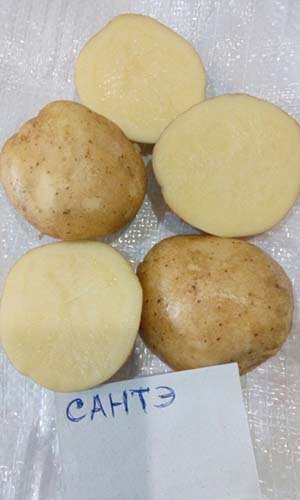
The taste of the Santa potatoes is good. The pulp does not darken during the cooking process. Suitable for frying, cooking French fries and chips. Not suitable for mashed potatoes and cooking.
Characteristics of the Sante variety:
- ripening period - medium early (80-90 days);
- tubers are oval;
- the structure of the peel is smooth;
- peel color - yellow;
- pulp color - light yellow;
- the depth of the eyes is shallow;
- starch content - 10-14%;
- yield per one hundred square meters - up to 570 kg;
- the number of tubers per bush - up to 20;
- the average weight of 1 tuber is 90-120 g;
- marketability is good
- keeping quality - 92% (good).
Santa is distinguished by erect tall shoots and white inflorescences.
Recommended for planting regions: North, North-West, Central, Volgo-Vyatka, Nizhnevolzhsky, Uralsky, West Siberian, Far East.
Patent holder and / or originator of the variety: Agrico U.A. (Holland).
Svitanok Kiev
Medium early variety, versatile, high yield, excellent taste.
It adapts to any type of soil, resistant to the Colorado potato beetle.
Resistant to potato cancer and rhizoctonia. Medium resistant to mosaic viruses, common scab, black leg. Moderately susceptible to late blight. Susceptible to nematode and leaf roll virus.
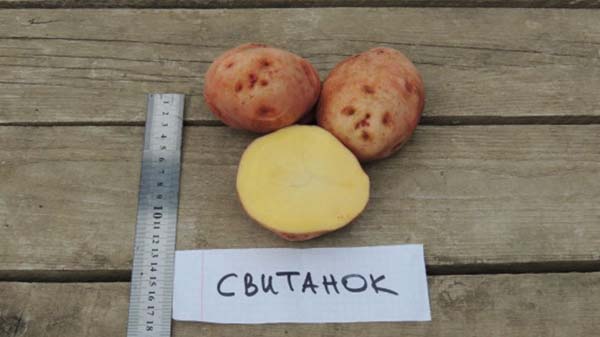
The taste is excellent. It boils well, suitable for mashed potatoes.
Characteristics of the Svitanok Kievsky variety:
- ripening period - medium early (80-90 days);
- the shape of the tubers is round;
- the structure of the peel is smooth;
- peel color - pink;
- pulp color - cream;
- the depth of the eyes is shallow;
- starch content - 16-19%;
- yield per hundred square meters - up to 460 kg;
- number of tubers per bush - 8-12
- the average weight of 1 tuber is 100-130 g;
- marketability is good;
- keeping quality - 95% (good).
The appearance of the plant is low, erect. Inflorescences are light red-violet.
Recommended for planting regions: North-West, Central, Middle Volga, Ural, West Siberian, Far East.
Patent holder and / or originator of the variety: Institute of Potato Growing UAAS (Ukraine).
Scarb
Mid-season variety, for table use, high yield, normal taste.
Suitable for growing on all types of soil, responds well to applied fertilizers. Medium drought tolerant, sensitive to waterlogging in the early stages of growth. To obtain fast and uniform shoots before planting, it needs germination or heating of tubers. In addition, planting should only be carried out with whole tubers. Moreover, planting should be deep, followed by high hilling after germination.
Resistant to wrinkled, striped mosaics. Resistant to the causative agent of potato cancer and nematodes. Susceptible to late blight pathogen in tops and tubers.
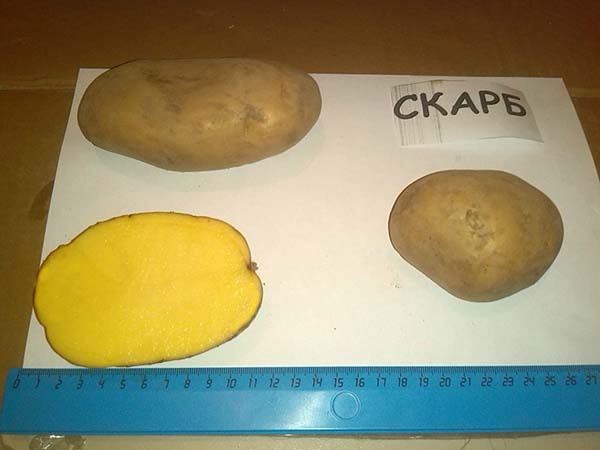
The taste is satisfactory and good. Culinary type B. The pulp does not boil over during cooking (boil-through is weak) and does not darken. The variety is recommended for making salads, chips, potato pancakes (pancakes), French fries.
Characteristics of the Scarb variety:
- ripening period - mid-season (90-110 days);
- tubers are oval;
- the structure of the peel is smooth;
- peel color - yellow;
- the color of the pulp is yellow;
- the depth of the eyes is very shallow;
- starch content - 12-17%;
- yield per hundred square meters - 253-411 kg (maximum up to 508 kg);
- the number of tubers per bush - 10-14;
- the average weight of 1 tuber is 94-138 g;
- marketability - 84-99%;
- keeping quality - 88-99%.
The variety is distinguished by medium-sized semi-upright bushes of an intermediate type. The leaves are small and open, dark green in color. No or very slight waviness in the edge. Inflorescences are white. Berry formation is rare.
Recommended for planting regions: North-West, Central, Volgo-Vyatka, Ural.
Patent holder and / or originator of the variety: RUE "Scientific and Production Center of the National Academy of Sciences of Belarus for Potato and Fruit Growing" (Belarus).
Luck
Early variety, table variety, high-yielding, normal (satisfactory) taste.
Productivity is stable in a favorable climate for crops. The choice of soil does not matter. It tolerates well both waterlogging and lack of moisture in the soil.
Moderately susceptible to late blight in tops and moderately resistant to tubers. Not damaged during transportation (resistant to mechanical damage).
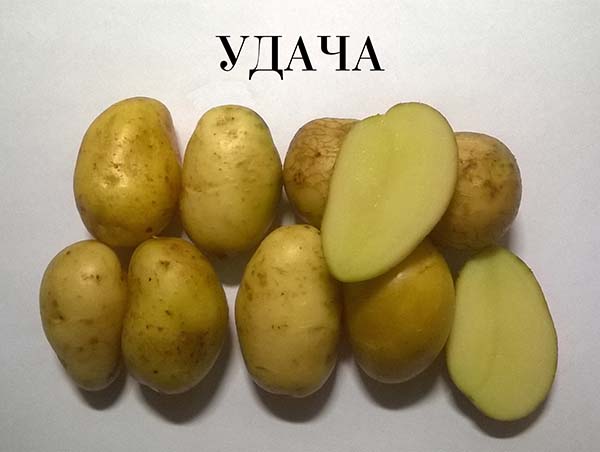
Fair to good taste. Culinary type B. The digestibility is weak, the pulp darkens slightly. Suitable for making soups and salads, as well as frying, making fries and chips.
Characteristics of the variety Luck:
- ripening period - early (70-80 days);
- the shape of the tubers is round-oval;
- the structure of the peel is smooth;
- peel color - light beige (cream);
- the color of the pulp is white;
- the depth of the eyes is shallow;
- starch content - 12-15%;
- yield per hundred square meters - 300-500 kg;
- the number of tubers per bush - up to 10-14;
- the average weight of 1 tuber is 100-150 g;
- marketability - 96%;
- keeping quality is good;
The appearance of the plant is medium, semi-spreading. Leaves with large lobes, dark green. Inflorescences are snow-white. Berry formation is rare.
Recommended regions for planting: North-West, Central, Volgo-Vyatka, Central Black Earth Region, North Caucasus, Middle Volga, Ural, Far East.
Patent holder and / or originator of the variety: FGBNU “All-Russian Research Institute of Potato Farming named after A.G. Lorkha (Russia).
List of other potato varieties for the Urals (only names, no description and characteristics)
Also, the following potato varieties are suitable for growing in the Ural region (alphabetically):
- Alekseevsky;
- Antonina;
- Arosa;
- Aspia;
- Bashkir;
- Belousovsky;
- Birsky;
- Burnovsky;
- Spring is white;
- Volare;
- Miner;
- Elena;
- Zyryanets;
- Irbit;
- Crown;
- Body;
- Labadia;
- Leader;
- Lina;
- Lukyanovsky;
- Hope;
- Naiad;
- Nikulinsky;
- Oredezhsky;
- Ramos;
- Romano;
- Sappho;
- September;
- Story;
- Fast-growing;
- Bullfinch;
- Spiridon;
- Tarasov;
- The dashing man;
- Early Morning;
- Charoite;
- Evolution;
- Excellence;
- The effect.
Note! The list of potato varieties for the Urals is made in accordance with the regions of admission of the "Federal State Budgetary Institution" State Commission of the Russian Federation for Testing and Protection of Breeding Achievements ".
So, now, as a resident of the Ural region, it will not be difficult for you to choose the potato variety you like, order it online or buy it in a special garden center and plant it on your garden plot.

